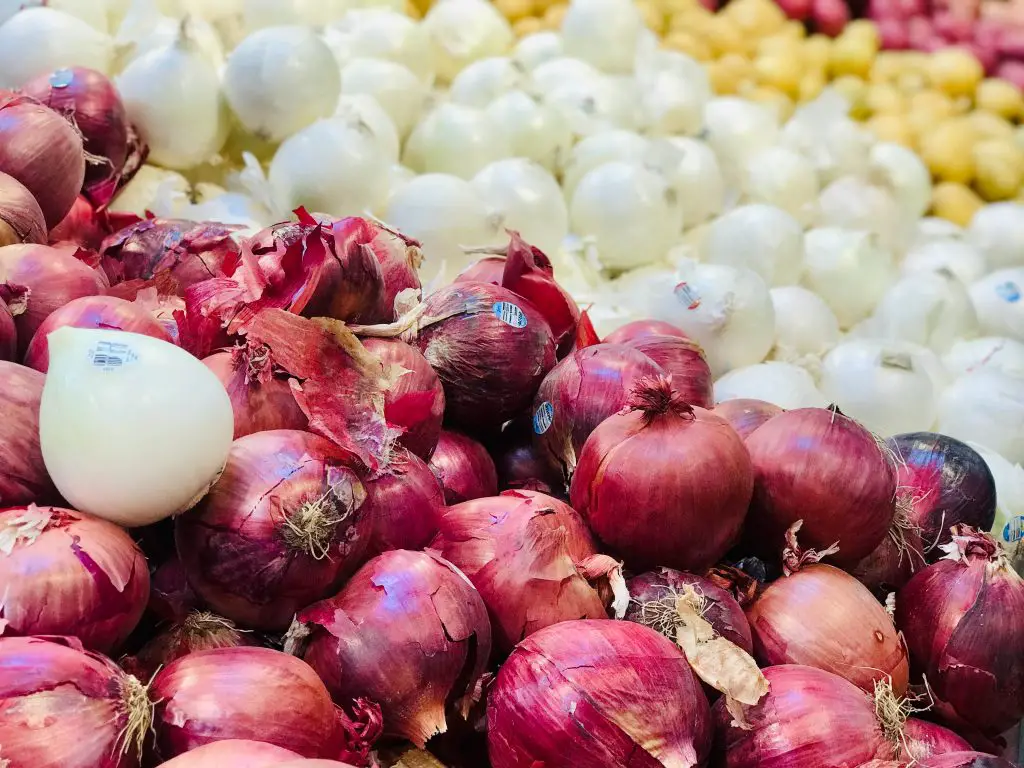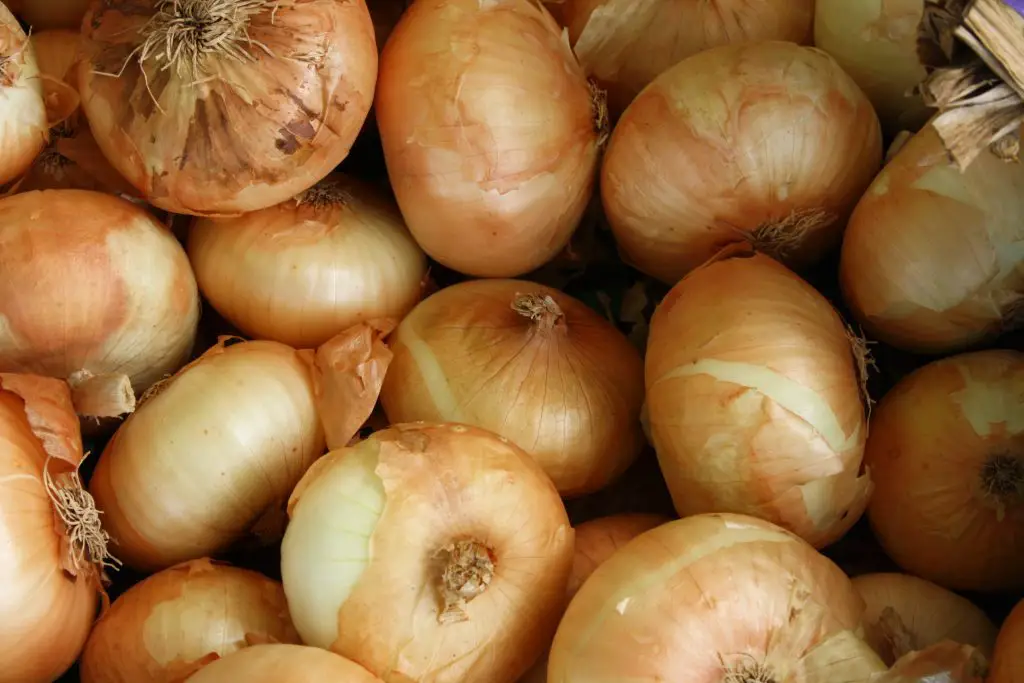How Many Onions Grow From One Bulb? Onion is a popular vegetable that is easy to grow in the garden. The crop produced can be stored for many months which means it is possible for a home gardener to become self-sufficient with their onions. Onions can be grown from onion sets (small bulbs) or onion seeds each has its advantages and disadvantages.
A single Onion bulb or a single Onion seed will produce one Onion. The size of the Onion will vary depending on the variety and the growing conditions. The cheapest way to produce your own Onions is to grow them from seed, a single packet of seed is often sufficient to supply Onions for the year.
Onion Sets Vs Seed: Advantages and Disadvantages
Growing Onions from seed is the most common way that gardeners produce a crop. Growing the plants from seed has several advantages over onions sets.
- Seeds are low cost
- There is a wider choice of varieties
- They produce a higher yield per square foot due to the ability to multisow seeds (discussed later in the article)
However, the primary advantage of using an Onion sets is it will produce an Onion crop earlier than any other method because the Onion has already started to produce an Onion Bulb. Using Onion sets typically advances the harvest by approximately 4 to 6 weeks.
However, this timing advantage can be somewhat mitigated if early varieties are grown. Another common problem that gardeners encounter with onion sets is birds are known to pull out the onion bulbs when they are first planted, which does not happen with onions produced by seed. This problem can be overcome by using netting to prevent access.

What Are The Different Types Of Bulb Onions?
Onions can be classified into three main groups; short, intermediate, and long day Onions. This classification referred to the number of daylight hours required for the plants to form bulbs. This vegetable is one of the few where it is advantageous to live in cooler regions further away from the equator as it increases the range of onions that can be grown.
For those living in equatorial regions you are limited to growing short-day varieties as the period of daylight remains relatively constant but short compared to daylight hours regions further north or south in the peak of summer. In these regions short, as well as medium, and sometimes long day length onions can be grown.
The capability to grow different day-length onions is advantageous because shorter day-length varieties produce earlier crops simply because bulb formation within the plant is initiated earlier in the season. However, later ones tend to store better. A brief description of the categories of Onions is provided below.
Short Day Onions
Short Day Onions Require Around 10-12 Hours Of Daylight to create a bulb. These varieties can be grown in any region but are the only type that can be grown in regions 35 Degrees Latitude North or South of the equator. The Onions within this group have a sweeter taste due to their higher sugar and water content. The increased water content limits their capacity to be stored making them suitable for immediate use only.
Intermediate Day Onions
These Varieties Require A Day Length Of Around 13 to 14 hours per day, to create a bulb. They are most suited to regions that are between 35 to 45 degrees, from the equator.
Long Day Onions
Long Day refers to Onions that can only be grown at Latitudes of 45 Degrees or more. These varieties require 15 hours or more of daylight, to create a bulb.

How To Grow Onions From Onion Sets
One big advantage of growing onions from sets is it is easier than growing them from seed, and they are perfect for the beginner gardener, with a small vegetable garden. Onion sets are available as Autumn and Spring planting varieties, however, the vast majority of gardeners tend to put the bulbs in the Spring.
The main advantage of planting in Autumn, is that these crops will be ready to harvest even earlier than those bulbs planted in Spring. However, a limiting factor associated with the planting in Autumn is temperature, if winter minimums fall below 20°F (-7°C) the bulbs will not survive.
When planting Onion Sets it is important to select a sunny location, as Onions are sensitive to day length. Onions prefer rich moist soil that is well-drained and slightly acidic. However, Onions will tolerate a wide variety of soil types.
Onions Sets should be placed in the ground with the basal plate pointing downwards and the pointy end facing upwards. The pointy end should protrude from the soil slightly so that bulb has some access to light. As mentioned earlier in the article birds have a tendency to pull them out of the ground in the early part of Spring as such it is important to protect them with something like a row cover or cloche.
Once planted the Onions sets require very little maintenance apart from watering regularly and keeping the weeds clear. In terms of harvesting, Onions can be picked at any stage but once they have reached their full maturity their stems will start to become brown and fall over. This is an indication that the Onion Bulbs have reached their maximum size and will not get any larger.

How To Grow Onions From Seed
Onions are a hardy frost tolerant plant that allows the seeds to be planted quite early in the season. Most gardeners plant Onions seeds from late winter to early Spring, however, this is dependent on what your particular climate will allow. In locations with milder winter climates, it is possible to plant onion seeds in Autumn, as most varieties are hardy to -6°C (20°F).
Planting at this stage will allow for a slightly early harvest however it is only a matter of weeks rather than months. This is because irrespective of when you plant you must wait for the daylight hours to be long enough to initiate bulb formation in Spring.
Onion seeds can be sown directly into the soil in the garden, however, I recommended that you start Onions in modular trays because it allows greater control over the growing conditions and young seedlings don’t occupy garden space, allowing it to be used for other Winter vegetables.
Multi-Sowing Onions
The traditional approach to planting onions is to plant them individually which is time-consuming. The alternative method, which has several advantages, is to plant seeds in clumps. This method is sometimes referred to as multi-sowing, reduces the greenhouse space required because it allows a larger number of seeds to be sown in a single tray.
The second key advantage is that the clumps are much faster to plant and there is less root disturbance. It also makes the management of weeds significantly easier, the reason for this is that the clumps can be spaced a reasonable distance apart, 10 inches or so. This allows a Dutch Hoe to be used to removed weeds, which is significantly faster than hand weeding.
When sowing seeds in clumps it is best to aim for 4-5 plants per module. To ensure that you get at least that number of plants in clump it is best to aim for 5 to 7 seeds per module as you can always thin the number of plants out prior to transplanting them.
However, it is important to note that to grow onions of a reasonable size it is important to thin them out as any more than 5 Onions in a clump will result in the production of small bulbs. However, one way to get the absolute maximum out of the onion clumps is to leave the additional plants in the clumps and harvest some of them as Spring Onions, prior to the formation of bulbs.
Planting Seeds
When planting seeds in a tray start by filling them with seed raising mix and level the mixture within the trays. Then compact the plants down into the cells with your fingers and refill the tray. Repeat this process until you have a firm plug of soil in each cell.
Compacting the soil within the trays is advantageous because it makes handling the clumps of seedlings much easier when they are transplanted as the contents of cell can be taken out as a single plug which also minimizes root disturbance.
Once seeds have been planted Onion seedlings will need to spend 6 weeks in the seed trays. However, unlike some other seedlings, Onions can be left in the modules for longer periods of time, if space is not yet available in the garden.
Seedling clumps should be placed 12 inches (30 cm) apart in the soil. In terms of soil conditions plants grown from seed prefer the same conditions as onion sets, which is a rich moist slightly acidic soil. To ensure that the soil remains moist it is important to water the plants regularly.

Harvesting and Storing Onions
Onions are a vegetable that can be picked at any stage in its life cycle and eaten, however to maximize the yield onions need to be allowed to fully mature. In the case of intermediate or long day varieties, this will also allow the plants to store better.
The clearest sign that the onions have reached full maturity is when the tops of the plants turn brown and begin to collapse. At this point they will not get any larger and should be picked for long-term storage.
To storage onions for the longer term, it is important that they be dried for at least 2 weeks, or possibly longer. When they are fully dry, the skin should be flaky and the stems should be completely shriveled up. If there is doubt about whether an Onion is fully dry leave them for longer.
If you have limited space to lay out the Onions to dry one possible option to reduce the space is to use stackable bread crates as they are wide and flat with plenty holes in them which allows good ventilation. They are also a potential option for longer-term storage as well.
Ideally, Onions should be stored in well-ventilated containers in a cool and dry location. The other option to maximize ventilation is to braid the Onions onto a string.
To braiding Onions start with a single Onion that is securely tied onto the end of a string, by its stem. The other end of the string is attached securely to the point you wish to hang the Onions from, throughout the storage period.
To create the next layer, pick 2 Onions, of approximately the same size and wind the stems together. To do this successfully, around 8-10cm (3-4 inches) of the dried stem, is required. When this process is complete, the 2 Onions should be securely attached to each other, with about 5cm (2 inches) between the bulbs. Wind the section of stem between the two Onions around the string, once or twice, before pushing it downwards, until the Onions come into contact with the layer of first Onions. Repeat this process, until the braid has reached the desired height.
As these instructions may be a little hard to follow, it may be worth watching a video of the Head Gardener of Chilton Estates, demonstrating the technique. The video is taken from the BBC series Wartime Kitchen and Garden, go to 8 minutes and 16 seconds of the video to find the section on Onions.
